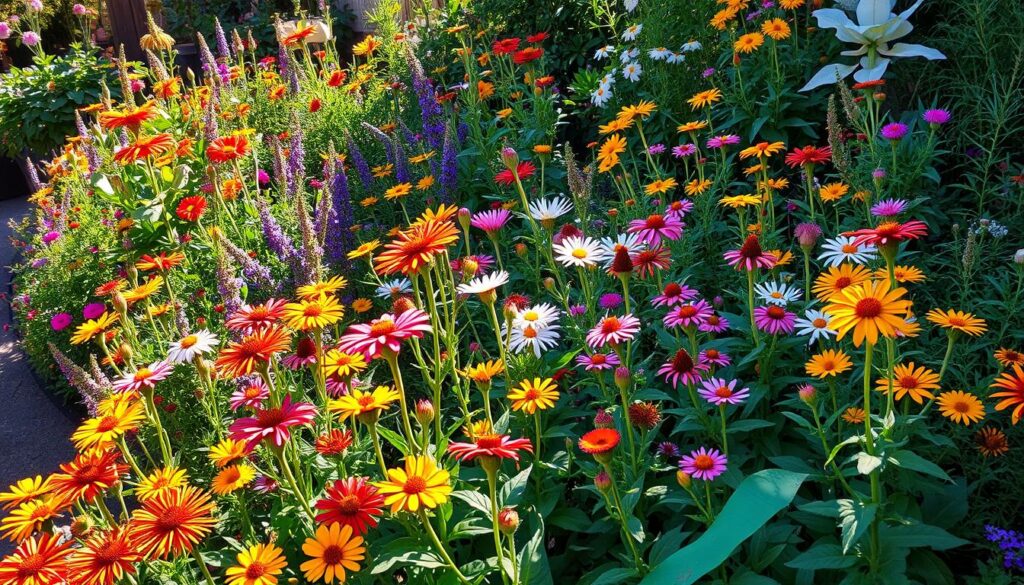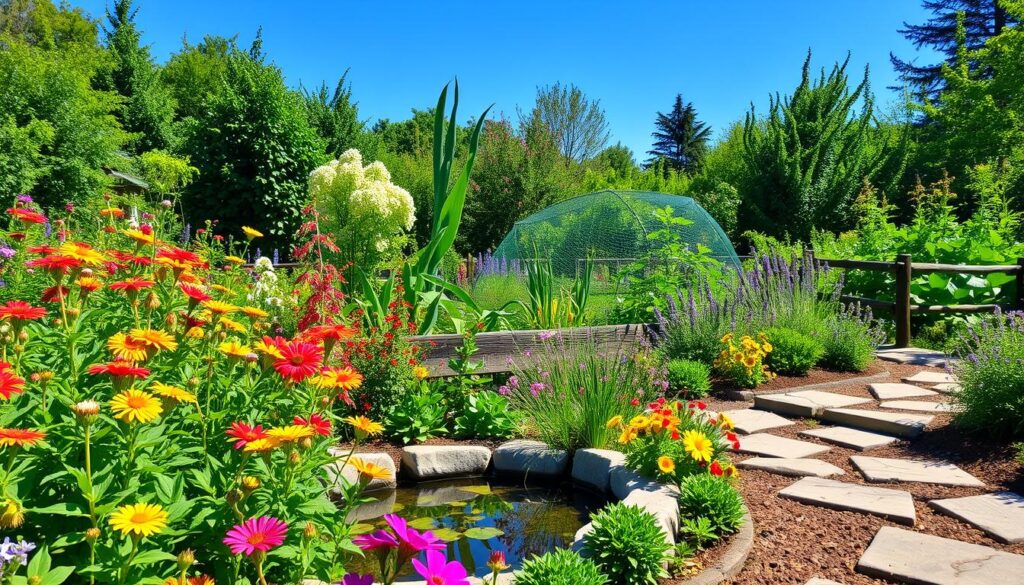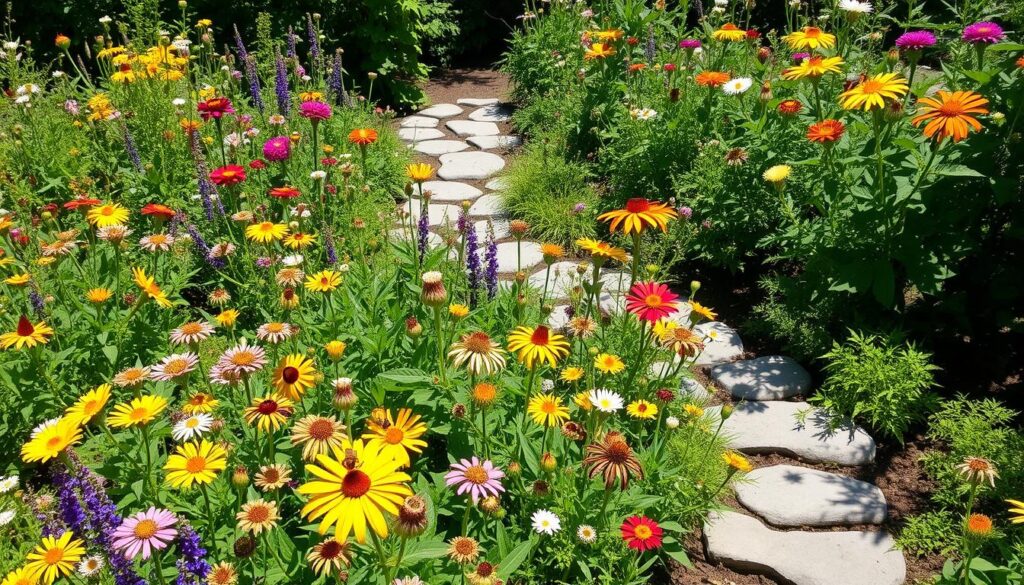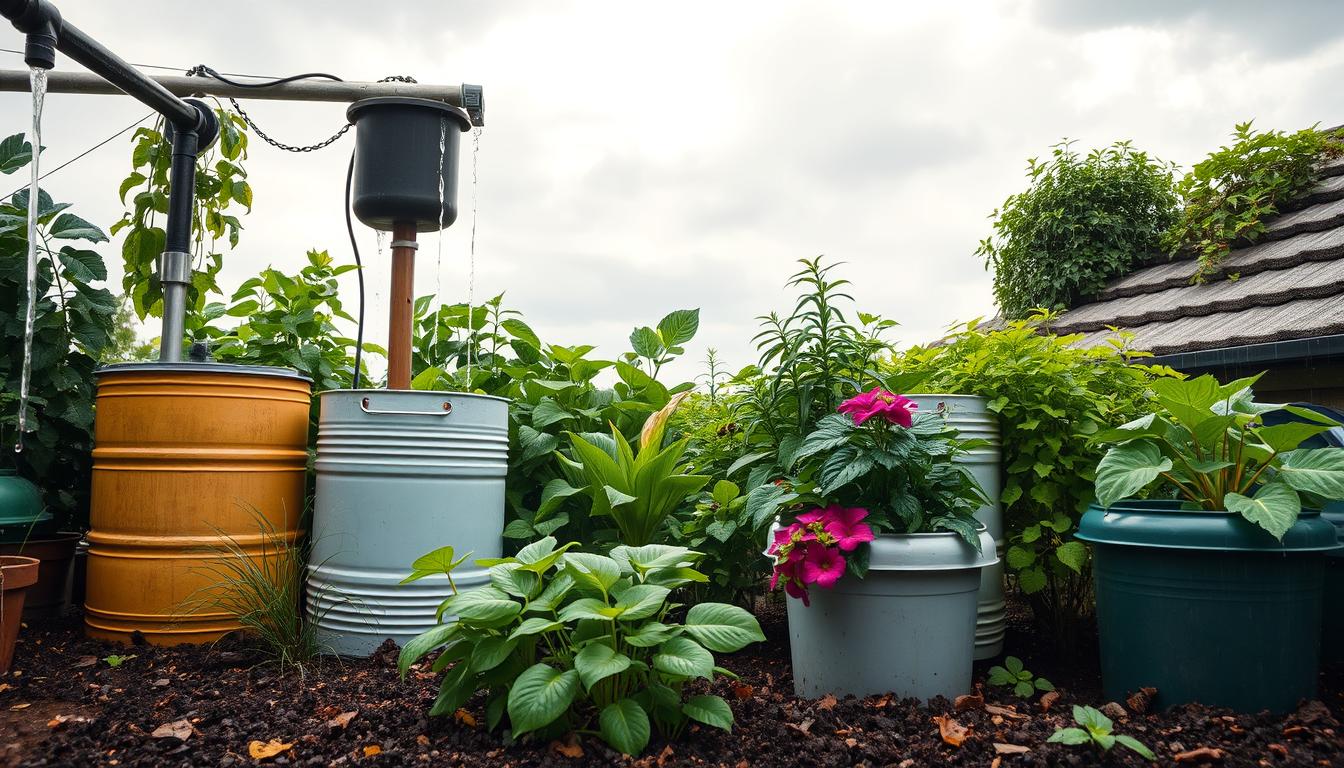Imagine stepping into your backyard on a warm sunny day. You’re surrounded by the buzz of bees and the flutter of butterflies. This is what many gardeners dream of when they think of a pollinator-friendly garden. They want to support these vital creatures while making their garden beautiful.
Creating a garden that welcomes pollinators is key. It boosts biodiversity and brings vibrant flowers and fruits. By using native plants, you help protect pollinators facing big declines. This section shows how native plants can make your garden a haven for these creatures.

Key Takeaways
- Creating a pollinator-friendly garden aids in the conservation of bees, butterflies, and birds.
- Native plants are specially adapted to local environments, making them ideal for attracting pollinators.
- Fostering a healthy ecosystem supports biodiversity and enhances your garden’s productivity.
- Implementing sustainable gardening practices benefits both your landscape and the environment.
- Pollinator gardens can be both beautiful and functional, contributing to food security through plant reproduction.
Understanding Pollinators and Their Importance
Pollinators are key to healthy ecosystems. They do more than just pollinate flowers. They help plants reproduce, increase biodiversity, and boost food production. By using native plants in gardens, we can help garden pollinators thrive. Each pollinator has its own needs, and knowing these can help attract them to our gardens.
The Role of Pollinators in Ecosystems
Pollinators help plants make seeds. This is vital for plant diversity and food for humans and animals. About 75% of the world’s food crops need pollinators to grow. This shows how important pollinators are for our food.
A variety of plants in an ecosystem is good for all living things. It keeps the ecosystem balanced and healthy.
Types of Pollinators You Can Attract
There are many types of pollinators, each needing different things. Knowing this helps us create welcoming spaces for them. Common garden pollinators include:
- Bees: Bees are the best pollinators and help grow many fruits and vegetables.
- Butterflies: These pollinators love flowers with lots of nectar and help plants cross-pollinate.
- Hummingbirds: Hummingbirds prefer flowers with long tubes and help certain plants grow.
- Bats: Bats are important pollinators, especially in tropical areas, but are not as well-known.
By growing native plants, we can make our gardens a haven for these pollinators. Choosing the right plants meets the needs of different pollinators.
| Pollinator Type | Preferred Flowers | Benefits to Garden |
|---|---|---|
| Bees | Sunflowers, Lavender | Increases fruit yield |
| Butterflies | Milkweed, Coneflower | Enhances biodiversity |
| Hummingbirds | Bee Balm, Trumpet Vine | Attracts bird life |
| Bats | Night-blooming Cereus, Agave | Pollinates nocturnal plants |
Knowing about native plants and pollinators helps us garden better. By choosing the right plants, we help these important creatures. This makes our gardens more vibrant and healthy.
Benefits of Native Plants for Pollinators
Using native plants in your garden is a big win for pollinators. These plants are perfect for our local environment. They not only grow well here but also feed and house many pollinators.
Why Choose Native Plants?
Native plants fit right into our ecosystem, attracting pollinators that go well with them. The perks of using native plants include:
- They need less care because they’re made for our climate.
- They use less water than plants from other places.
- They help local wildlife by offering homes and food.
- They make our ecosystems healthier by supporting more life.
Supporting Biodiversity Through Native Plants
Planting native species helps our ecosystems grow strong. They do this by:
- Offering food like nectar and pollen to many pollinators.
- Creating safe places for pollinators to live and nest.
- Helping the soil by supporting good bugs and microorganisms.
| Aspect | Native Plants | Non-Native Plants |
|---|---|---|
| Adaptation | Well-adapted to local climate | May require extra care |
| Water Needs | Lower water usage | Higher water needs |
| Pollinator Attraction | Specifically attract local pollinators | May attract fewer local species |
| Biodiversity Support | Enhances local ecosystems | Often lacks ecological value |
Creating a Pollinator-Friendly Garden with Native Plants
Creating a garden that helps pollinators needs careful thought on plants, layout, and design. It’s key to think about the environment and how plants interact with it. This part talks about important design tips and how to use native plants in your garden.
Key Considerations for Garden Design
Creating an eco-friendly garden starts with planning. First, check your garden’s soil, sun, and water. Knowing these helps pick the best plants for your area. A good layout helps different pollinators visit your garden.
- Soil Preparation: Test and amend soil to ensure optimal nutrient availability.
- Sunlight Access: Choose plants that match sunlight preferences—full sun, partial shade, or full shade.
- Water Availability: Introduce water sources for hydration, reinforcing an ecosystem conducive to pollinators.
Incorporating Native Plants into Your Landscape
Using native plants in your garden fits well with local ecosystems. Pick a variety of plants to attract different pollinators. This variety helps your garden stay healthy and strong. Planting in layers gives insects shelter and nesting spots, making your garden a rich habitat.
“By planting native species, we create ecosystems that significantly benefit local biodiversity.”
Here’s a quick list of great native plants:
| Plant Name | Attracted Pollinators | Sunlight Requirements | Bloom Time |
|---|---|---|---|
| Bee Balm | Bees, Butterflies | Full Sun | Summer |
| Black-eyed Susan | Bees, Butterflies | Full Sun | Summer to Fall |
| Lobelia | Hummingbirds | Partial Shade to Full Sun | Summer |
| Purple Coneflower | Bees, Butterflies | Full Sun | Summer to Fall |

Designing a Garden for Pollinators
Starting a pollinator garden means picking the right spot and layout. Knowing the environment is key to success. Placing plants wisely helps them grow well and attracts pollinators, making the garden lively.
Choosing the Right Location and Layout
Think about these when designing a pollinator garden:
- Sunlight: Most plants love full sun. Try for six to eight hours of direct sun daily.
- Wind Protection: Place the garden where it’s not too windy. Use hedges or fences to keep it calm.
- Soil Quality: Check the soil for drainage and pH. Native plants like well-draining, organic-rich soil.
- Water Sources: Add water features or shallow dishes for pollinators and wildlife.
Companion Planting to Attract Beneficial Insects
Companion planting is a smart way to improve your garden. It’s about growing plants together for mutual benefits. This creates a healthy space for pollinators and keeps pests away. Here are some good pairings:
| Plant Pairing | Benefits |
|---|---|
| Bee Balm & Cornflowers | Attracts bees and butterflies, adding color. |
| Marigolds & Tomatoes | Keeps pests away and draws in pollinators for tomatoes. |
| Lavender & Zucchini | Helps pollination and keeps squash bugs away. |
| Echinacea & Black-eyed Susans | Feeds butterflies and looks great. |
Using these design tips and planting techniques will help attract pollinators. It boosts biodiversity and makes your garden beautiful and useful for all life.

Attracting Pollinators with Native Plant Species
Native plants are key for pollinators, offering nectar and pollen. They are crucial for a pollinator-friendly habitat. By choosing the right plants, gardeners can beautify their spaces and help pollinators. Here, we explore top native plants and seasonal planting tips for a year-round garden.
Top Native Plants for Pollinators
- Butterfly Weed (Asclepias tuberosa) – A vibrant orange flowering plant that attracts various butterflies, particularly monarchs.
- New England Aster (Symphyotrichum novae-angliae) – This late-blooming aster offers essential nectar in the autumn, sustaining pollinators as they prepare for winter.
- Black-Eyed Susan (Rudbeckia hirta) – Known for its striking yellow petals and compostable seeds, this flower is a favorite among bees and butterflies.
- Purple Coneflower (Echinacea purpurea) – With its large, daisy-like flowers, this plant attracts many insects, including bees and butterflies, while providing seeds for birds.
Seasonal Planting for Year-Round Support
Seasonal planting keeps flowers blooming all year. This helps pollinators by offering food constantly. Here are some planting tips:
- Spring Planting: Start with early bloomers like crocus and wild strawberry to kickstart pollinator activity.
- Summer Bloomers: Add vibrant plants such as bee balm and zinnias for a colorful, nectar-rich environment.
- Fall Color: Include late-season flowers like goldenrod and asters to feed pollinators before winter.
Eco-Friendly Gardening Practices to Support Pollinators
Using eco-friendly gardening practices helps your garden and pollinators. Organic gardening and creating a welcoming space support a healthy ecosystem. This helps both plants and pollinators thrive.
Organic Gardening Techniques
Organic gardening uses natural methods to improve soil and grow plants. It avoids harmful chemicals, making a safer place for pollinators. Techniques like composting and crop rotation help.
These methods make soil better, plants stronger, and reduce chemical harm to insects.
Water Sources and Shelter for Pollinators
Having water sources is key for pollinators. Use shallow dishes or small ponds for water. These also provide homes for other creatures.
Creating shelter for pollinators is also important. Plant bee hotels or dense plants for nesting sites. This makes your garden a welcoming place for pollinators.
| Practice | Description | Benefits |
|---|---|---|
| Organic Gardening Techniques | Use of natural fertilizers and pest control | Healthier plants and soil, safer for pollinators |
| Water Sources | Shallow dishes and small ponds | Provides hydration and a habitat for wildlife |
| Shelter for Pollinators | Bee hotels and dense plantings | Supports nesting and protection from predators |
Conclusion
Creating a garden that helps pollinators is key for a healthy environment. Native plants are vital for bees, butterflies, and birds. They make your garden a home for these important species.
Every small action in gardening helps the planet. By using fewer pesticides and offering water, you help pollinators. Also, planting different types of native plants is crucial.
Start your gardening journey by making your garden friendly to pollinators. Think about how you can plan your garden and choose the right plants. Every choice you make helps pollinators and makes your garden beautiful and strong.
FAQ
What is a pollinator-friendly garden?
A pollinator-friendly garden attracts bees, butterflies, and birds. It uses native plants for food and shelter. This garden helps biodiversity and ecological health.
Why should I use native plants in my garden?
Native plants fit local climates and soil well. They support local pollinators with the food they need. Using native plants makes your garden sustainable and supports pollinators.
How can I attract pollinators to my garden?
To attract pollinators, choose native plants that bloom at different times. Plant in clusters and provide water. A diverse plant habitat makes your garden more appealing.
What are some benefits of a pollinator-friendly garden?
Benefits include more biodiversity and better ecosystem health. Your garden will also look better and be more productive. Supporting pollinators helps agriculture too, as many crops need them to grow.
What eco-friendly gardening practices should I consider?
Use organic gardening to avoid harmful chemicals. Choose natural fertilizers. Provide water and shelter with specific plants for pollinators.
How do I design a garden specifically for pollinators?
Design your garden in a sunny spot. Arrange plants in layers. Include a variety of species to attract different pollinators all year.
What are some top native plants for attracting pollinators?
Top native plants include milkweed, coneflowers, black-eyed Susan, and bee balm. They offer vital food for pollinators and help the ecosystem thrive.
Why is seasonal planting important for pollinators?
Seasonal planting gives pollinators food all year. By staggering plant blooms, you support pollinators continuously. This helps keep their populations strong.




